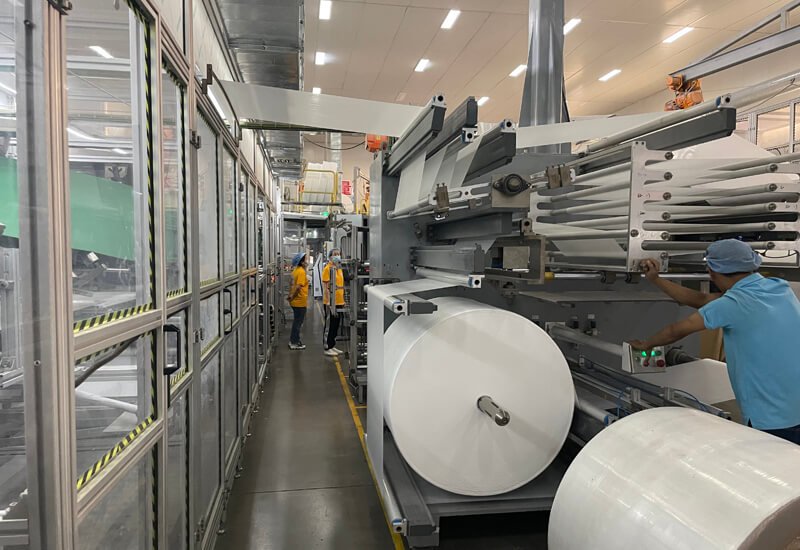The adult diaper market is a dynamic and essential sector of the healthcare industry, providing dignity and comfort to millions of adults worldwide who face incontinence issues. As the global population ages, the demand for high-quality adult diapers increases, presenting unique challenges and opportunities for manufacturers. This article aims to explore the intricacies of the adult diaper manufacturing process, addressing common challenges and offering practical solutions to ensure the industry can meet the needs of its diverse clientele efficiently and sustainably.
Raw Materials and Their Challenges
Types of Materials Used
Adult diapers are primarily composed of several key materials, each selected for its specific properties. The core materials include:
- Fluff Pulp: Sourced mainly from wood pulp, fluff pulp forms the absorbent core of the diaper.
- Super Absorbent Polymer (SAP): SAP is crucial for its high absorbency, locking in moisture to prevent leaks.
- Non-woven Fabrics: These fabrics create the diaper’s body, providing comfort and skin protection.
- Elastics and Adhesives: Used to ensure the diaper fits securely and comfortably around the wearer.
Each component plays a vital role in the functionality of the final product, and sourcing these materials involves navigating a complex global supply chain.
Sourcing Issues and Sustainability Concerns
Manufacturers need help sourcing raw materials. The primary concern is the sustainability of these materials as environmental regulations tighten and consumer preferences shift towards eco-friendly products. Fluff pulp, for example, must be sourced from sustainably managed forests to meet certain environmental certifications. Similarly, the production and disposal of SAP and plastics used in diapers raise concerns about long-term environmental impact.
To address these issues, manufacturers are increasingly looking towards innovative, sustainable materials such as biodegradable SAP and recycled non-woven fabrics. However, integrating these new materials into existing production processes can take time and effort.
Manufacturing Techniques
Overview of Production Processes
The manufacturing process for adult diapers involves several critical steps, each requiring precision and efficiency. The process typically includes:
- Pulp Preparation: Fluff pulp is processed into a fluffy, absorbent material.
- SAP Application: SAP is evenly distributed across the pulp to maximize absorbency.
- Formation of the Absorbent Core: The pulp and SAP mixture is formed into the core shape.
- Assembly: Non-woven fabrics are layered to form the outer layers of the diaper, with elastics and adhesives applied to ensure fit and comfort.
This streamlined process is essential for maintaining high production volumes and meeting market demands.
Common Challenges in Assembly and Automation
Despite advancements in manufacturing technology, several challenges persist:
- Machine Downtime: Unexpected equipment failures can halt production, leading to significant losses.
- Quality Control: Ensuring each diaper meets stringent quality standards is challenging, particularly at high production speeds.
- Material Handling: The precise placement of SAP and the integration of soft, non-woven fabrics require sophisticated machinery and skilled operators.
To overcome these challenges, manufacturers invest in advanced automation technologies and continuous staff training. Real-time monitoring systems are also increasingly used to predict and prevent potential failures, ensuring a smooth production flow.
By addressing these challenges through innovative solutions and sustainable practices, manufacturers can enhance efficiency and product quality, contributing positively to the adult diaper industry’s growth and reliability.
Quality Control Measures
Importance of Quality in Medical Products
Quality control is a critical aspect of adult diaper manufacturing, given the products’ medical necessity for individuals with incontinence. Ensuring high quality is not just about consumer satisfaction; it’s about preventing potential health risks such as skin irritations, infections, and leaks. Manufacturers must adhere to stringent quality standards to ensure their products are safe and effective.
Strategies for Ensuring Product Reliability
To maintain the highest quality standards, manufacturers employ several strategies:
- Regular Testing: Each batch of diapers undergoes rigorous testing for absorbency, durability, and comfort.
- Automated Inspection Systems: Advanced cameras and sensors are used throughout the production line to detect any defects in real time.
- Supplier Quality Management: Quality control starts with high-quality raw materials. Manufacturers carefully select and regularly audit suppliers to ensure all materials meet predetermined standards.
Implementing these measures helps manufacturers maintain a consistent product quality that meets both consumer expectations and regulatory requirements.
Market Demand and Consumer Preferences
Changing Demographics and Market Size
The demographic shift towards an older population globally has led to an increased demand for adult diapers. The market is expanding not only in size but also in the variety of products offered, driven by a population that values the quality of life and dignity in managing incontinence.
Adapting to Consumer Needs and Preferences
Consumers are looking for products that offer not only functionality but also comfort, discreteness, and skin-friendliness. This demand drives innovation in the sector, with companies exploring new materials and technologies to improve the softness, fit, and breathability of their products. For instance, the use of aloe-infused top sheets or fabric-like outer layers enhances the user experience by ensuring the diapers are both effective and gentle on the skin.
Environmental Impact and Sustainability
Waste Management Challenges
The disposable nature of adult diapers presents significant environmental challenges, primarily due to their high volume and non-biodegradable components. The accumulation of used diapers in landfills has become a pressing environmental issue.
Innovations in Eco-friendly Manufacturing
To mitigate these impacts, manufacturers are pioneering more sustainable practices, such as:
- Developing Biodegradable Components: Efforts are being made to replace traditional materials with biodegradable alternatives that break down more quickly in landfills.
- Recycling Programs: Some companies have started programs to recycle used diapers and repurpose them into new products, significantly reducing waste.
- Reducing Production Waste: Streamlining manufacturing processes and using materials more efficiently can minimize the waste generated during production.
These initiatives not only help reduce the ecological footprint but also align with the growing consumer demand for environmentally responsible products. By continuing to focus on sustainability, manufacturers can improve their competitiveness and contribute to a greener future.
Technological Advancements
Impact of Technology on Production Efficiency
Technological advancements play a crucial role in enhancing the efficiency and quality of adult diaper manufacturing. Automation and robotics have significantly reduced manual labor, minimized human error, and increased production speeds. Advanced software systems manage and optimize the entire production process from start to finish, ensuring precision in material handling and assembly.
Future Technologies in Diaper Manufacturing
Looking forward, the integration of Internet of Things (IoT) devices and Artificial Intelligence (AI) within manufacturing lines promises to revolutionize the industry further. These technologies can provide:
- Real-time data analytics.
- Predictive maintenance.
- Even adaptive manufacturing processes that respond dynamically to changes in material quality or production conditions.
Such innovations will not only enhance productivity but also push the boundaries of what is currently possible in diaper quality and customization.
Regulatory Compliance and Safety Standards
Overview of Global Regulations
Manufacturers of adult diapers must comply with a myriad of global safety and health regulations, which vary significantly from one country to another. These regulations often govern the materials used, the production processes, and even the labeling and disposal of the product. Navigating these regulations requires a deep understanding of legal and compliance issues across different markets.
Ensuring Compliance in Different Markets
To ensure compliance, companies invest in regulatory affairs teams that work closely with local and international bodies to monitor and adapt to new regulations. Regular audits and compliance checks are part of the operational routine, ensuring that every product shipped meets the necessary standards of the target market. This meticulous attention to compliance not only protects the end-users but also shields the company from legal risks and enhances its reputation in the market.
Distribution and Supply Chain Management
Logistics Challenges
Effective distribution is key to the success of adult diaper manufacturers, especially those serving an international market. Challenges in logistics can include managing fluctuating demand, optimizing inventory levels, and minimizing shipping delays. The complexity increases with the need to maintain product integrity and hygiene throughout the supply chain.
Strategies for Effective Distribution
To tackle these challenges, manufacturers often turn to advanced supply chain management software that integrates demand forecasting with inventory and logistics management. Strategic partnerships with reliable logistics providers are also crucial. These partnerships enable manufacturers to leverage expert knowledge and infrastructure, reducing the risk of delays and ensuring that products reach consumers in a timely and efficient manner.
Conclusion and Future Outlook
As we have explored throughout this article, the adult diaper industry is confronted with numerous challenges but is also ripe with opportunities for innovation and growth. From enhancing product quality to embracing sustainability, manufacturers are continuously seeking ways to improve and expand their offerings. Looking forward, the industry is expected to keep evolving with advancements in materials science, manufacturing technologies, and global market dynamics.
The future of adult diaper manufacturing will likely see an increased focus on eco-friendly practices and further personalization of products to meet the specific needs of diverse populations. By continuing to innovate and adapt, manufacturers can not only meet the current demands but also shape the future of this essential industry, ensuring they continue to provide invaluable support to individuals around the world.

